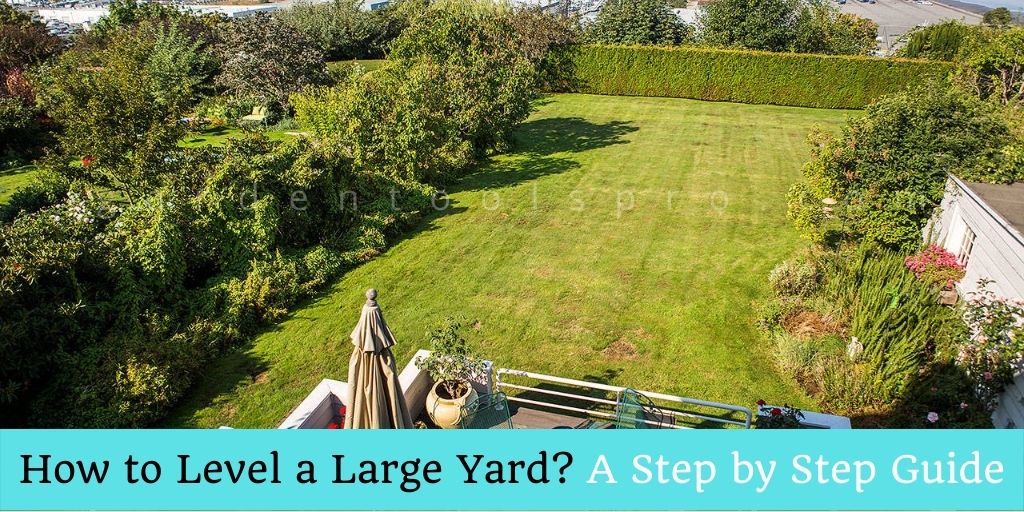There are a ridiculous amount of reasons for why you should level a yard and I could keep going on and on about the reasons, but that’s not what you signed up for. In this article, I am going to be giving you guys a detailed explanation and steps on how to level a large yard. And in the end, you will also be exposed to a few reasons why you should level a large yard.
Contents
- 1 Steps to Level a Large Yard
- 1.1 Step 1: Start by Mowing your Yard
- 1.2 Step 2: Look at the Amount of Thatch Residing at the Roots of the Grass
- 1.3 Step 3: Time to Get your Hands Dirty
- 1.4 Step 4: Get Rid of Grass in Sunken Areas and Fill the Space with the Soil Mix
- 1.5 Step 5: Even the Whole Yard Out
- 1.6 Step 6: Time to Water the Yard
- 1.7 Step 7: You Might need to Apply the Soil Mix Again
- 2 Why should you level your yard?
Steps to Level a Large Yard
Leveling a yard is not really a difficult thing and you definitely don’t need to go about searching for a professional to do it. Below are the steps you should follow to have a perfectly leveled lush green yard.
Step 1: Start by Mowing your Yard
The first thing you should be doing is mowing your yard and making sure you are not overdoing it such that your yard is left bald. Use a lawnmower and spend some time getting the grass to a perfect height. Once that’s done, you can move on to the next step.
Step 2: Look at the Amount of Thatch Residing at the Roots of the Grass
It’s time to give your eyes some intense work, take a look at the roots of the grass, and look for the amount of thatch hidden in there. If you don’t know what thatch is, it is a thick layer of organic matter, both dead and living. Remember that you don’t need to get rid of everything, a quarter to half-inch of thatch is not a problem. But if it exceeds that, you might have to get rid of it because the excess thatch doesn’t give the opportunity for the grass to get enough water and air.
Run a thatch rake over the grass to reduce and remove thatch. If you are looking for a faster way to get this done, a dethatching machine will help. You can rent it from any nearby home improvement store. You can buy it if you want but spending tons of money on something you’ll barely use is not the best decision to make.
Step 3: Time to Get your Hands Dirty
For this step, you need to mix sand, topsoil, and compost in order to create a dressing mix for the top area. This mix is basically used for filling out space underneath the grass or most necessarily the sunken areas. Make sure you mix 2 parts of topsoil and sand with 1 part of the compost. While the soil and compost give sufficient nutrients for the grass to grow, and helps in maintaining a leveled lawn because it doesn’t compact very easily.
Step 4: Get Rid of Grass in Sunken Areas and Fill the Space with the Soil Mix
In case your yard has low areas of more than 3 inches deep, you’ll have to get rid of the grass in that area and level it up with the soil mix from earlier. Make sure you take the grass around along with its roots. If you don’t, grass will grow all over again in the area.
Step 5: Even the Whole Yard Out
Now, you should start to spread the dressing mix that we’ve prepared earlier all around the yard and even the whole area out. Make sure you add about half an inch of the soil mix and not more than that. If more soil mix is thrown in, the grass might get suffocated and die. Sunlight is a very important element needed for the grass to survive so don’t cover the grass completely. Remember to really work your way into the low areas.
Step 6: Time to Water the Yard
In order for the soil mix to get incorporated into the grass and fill in any air spaces left, you’ll need to water the complete yard properly. This step will also energize the yard as the water starts the fusion of nutrients from the compost in your soil mix.
Step 7: You Might need to Apply the Soil Mix Again
Sometimes, your yard might not be settled with just one layer of the soil mix to level out completely. So, after you’ve watered the whole area, go over the entire yard again with more soil mixture. You might as well apply a second layer when the grass starts growing or when the first layer is put down. Use the same exact proportions and follow the same method to re-apply.
Why should you level your yard?
Leveling your yard doesn’t just make it look a lot more amazing but makes it safer as well. 9 times out of 10, a bumpy yard is an aesthetic or an unsafe issue but when the land is uneven, it might lead to water jamming in an area and leaving the other parts of the yard barren. To tackle all of these issues and keep the yard safe and aesthetic, you should level your yard.

